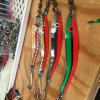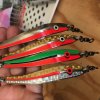treblig- gil d'Oliveira
Well-Known Member
Beach Journal October 6 2018
I am always searching for new ideas in creating casting spoon lures. Often the lures on the market seem to be made from the same mold that’s been on the market. Sometimes all the difference between them is a little variation.
I was visiting Robert Van Pelt at Pacific Net and Twine, a saltwater fishing tackle & gear-focused store in Parksville, BC. We were catching up on his web site and fishing tackle development thoughts and ideas. He showed me a lure called “ more silda“ . It was slimmer than the usual casting spoon. More like a needlefish and weighed 18 grams that’s 5/8 of an ounce. The shape allowed more of the weight to be centered to the lure. I could not bend it out of shape so I looks like it could take on allot of large targets without loosing its action form from the constant beating from our large salmon.
I couldn’t pass on them so I obtained two variations.
Some beaches on low tide have heavy dense eelgrass and are often under a foot below the surface. A challenge is to keep the lure when retrieving them near the surface of the water. We use 13-foot rods and by keeping the tip straight up and controlling the speed of retrieval we were able to keep this lure in this zone.
Today was another example when you struggle to get the bite. We used all of our go to lures even Randy’s lure that was successful the other day. Nothing would work. So time to put on the new lure. The strong wind was coming from the north over 15 kilometres. This would give extra distance on our casts. Salmon were showing 150 feet plus. I saw a school and made the cast. The winds were so strong it bowed the line spooling out and it took a good effort retrieving the slack. No sooner than that I caught up on the slack line the lure was slammed by a huge wild coho.
I hooked up two more and landed all beingwild. I guess the tackle bag is going to get heavier. A perfect example of what trying out new tackle can do for your success ratio.


I am always searching for new ideas in creating casting spoon lures. Often the lures on the market seem to be made from the same mold that’s been on the market. Sometimes all the difference between them is a little variation.
I was visiting Robert Van Pelt at Pacific Net and Twine, a saltwater fishing tackle & gear-focused store in Parksville, BC. We were catching up on his web site and fishing tackle development thoughts and ideas. He showed me a lure called “ more silda“ . It was slimmer than the usual casting spoon. More like a needlefish and weighed 18 grams that’s 5/8 of an ounce. The shape allowed more of the weight to be centered to the lure. I could not bend it out of shape so I looks like it could take on allot of large targets without loosing its action form from the constant beating from our large salmon.
I couldn’t pass on them so I obtained two variations.
Some beaches on low tide have heavy dense eelgrass and are often under a foot below the surface. A challenge is to keep the lure when retrieving them near the surface of the water. We use 13-foot rods and by keeping the tip straight up and controlling the speed of retrieval we were able to keep this lure in this zone.
Today was another example when you struggle to get the bite. We used all of our go to lures even Randy’s lure that was successful the other day. Nothing would work. So time to put on the new lure. The strong wind was coming from the north over 15 kilometres. This would give extra distance on our casts. Salmon were showing 150 feet plus. I saw a school and made the cast. The winds were so strong it bowed the line spooling out and it took a good effort retrieving the slack. No sooner than that I caught up on the slack line the lure was slammed by a huge wild coho.
I hooked up two more and landed all beingwild. I guess the tackle bag is going to get heavier. A perfect example of what trying out new tackle can do for your success ratio.


Last edited:










